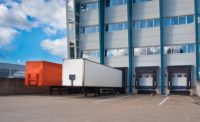Innovations in fleet management
Routing and scheduling software, telematics and alternative fuels lead the way




New routing and scheduling software integrated with telematics systems provides fleet managers with the tools they need to improve the delivery process. This combination enhances fuel efficiency, driver safety, connectivity/communications and integrated route management. The use of alternative fuels is another factor driving improvement in fleet management.
Meeting challenges
This is good news for snack producers and bakeries dealing with multiple challenges when it comes to delivering their products to market on tight schedules. These challenges include SKU proliferation, increased customer demands, shorter delivery lead times and crowded loading/unloading areas. Hundreds of variables make it difficult to manage costs, complicating the routing process.
Transport operators need to take advantage of current technology to meet these challenges. Vehicles of all sizes should be routed using sophisticated routing and scheduling software, ideally integrated with telematics systems that can track their movements in real time.
GPS tracking technology has improved, which means more visibility to where trucks are and their expected arrival time. “If a truck is running behind or even early, fleet managers can plan their labor and adjust their schedules to allow for a more-efficient off-loading process,” says Jesse Juett, senior business development representative, Zipline Logistics, Columbus, OH.
Advanced routing and scheduling software can cut overall delivery costs by 10 to 30 percent, according to William Salter, CEO, Paragon Software Systems, Dallas. “Sophisticated algorithms enable planners to incorporate individual driver availability in their plans. The software also allows them to create a feedback loop, where drivers and dispatchers can gather real world information, such as a problem at a customer’s receiving dock or an issue with a particular road.”
Delivery tools to improve communication and route management are not new. What is new is the realization that without a more-simplified approach to deploy these tools, they may not be properly utilized, according to Derek Curtis, vice president of sales, retail execution, HighJump, Minneapolis. “Areas such as mobile solutions and route optimization are two areas where the ‘how’ a tool is used has become as important, if not more important, than the bells and whistles.”
Driver management
Many tools are available to better manage the behavior of drivers. The federal Electronic Logging Devices (ELD) rule and subsequent initiatives have expanded the use of telematics across many industries. Thus, fleet managers are now able to see idle time, hard acceleration/deceleration and other maintenance-related data, which provides insight into driver behavior. “This allows managers to assess and adjust situations to reduce costs, and ensure that product distribution is being handled most effectively,” Curtis says.
Today’s route execution software gives a detailed account of exactly how delivery drivers perform against route plans, providing useful feedback regarding challenges and choices the drivers encounter, according to Salter. “In addition, the introduction of mandatory ELD to ensure that truck drivers are staying within mandated Hours of Service means drivers will want to take their hours right up to the limit, maximizing their earning power and the fleet operator’s ability to maximize drops per delivery.”
Driver behavior tools with powerful analytics and rich data are available in OEM partnerships and are inspiring a more-productive and safe mobile workforce, adds Ray Zujus, strategic customer success manager for food and beverage, Verizon Connect, Aliso Viejo, CA. “For example, Coach, a mobile gamification app that uses metrics derived from the rich data a company is pulling, creates a snapshot or leaderboard for workers in the field. The goal is to create friendly competition among teams to improve performance metrics the company sets, and empower drivers to compete against each other to be the best.”
Ford Motor Co., Dearborn, MI, offers Ford Telematics, which helps fleet managers monitor their vehicles. By keeping track through GPS and geofencing, they can more effectively plan and utilize their assets. “Fleet managers receive notifications and vehicle health alerts, which allows them to plan ahead and stay ahead on vehicle maintenance. Ford Telematics also makes it possible to monitor fuel consumption and identify areas of waste and the causes,” says Malene Lane, fleet brand strategy manager.
Fleet managers may want to consider specifying delivery vans with powertrains that include auto start-stop technology, which is standard on many Ford delivery vehicles, Lane adds. “Auto start-stop can reduce fuel consumption and vehicle emissions during city driving. When the vehicle comes to a stop, the engine automatically shuts off; air conditioning stays on, keeping the driver comfortable. The engine restarts when the driver’s foot leaves the brake pedal. This is great for bakery and snack delivery where the vehicle is under repeated stop-and-go usage.”
Alternative fuels
Given the volatility of gas prices, many fleet managers are investigating and using alternative fuels such as compressed natural gas (CNG). Propane autogas engines offer yet another option.
The Propane Education & Research Council (PERC), Washington, D.C., reports that, in 2018, Roush CleanTech, Livonia, MI, and Greenkraft Inc., Santa Ana, CA, introduced ultra-low NOx propane autogas engines that are 90 percent cleaner than mandated EPA standards. The new engine technology is classified as near-zero emission and has moved propane autogas closer to achieving zero emission levels.
“Propane autogas engines provide reliable performance, regardless of the temperature. Also, they don’t require added fluids, filters or engine block heaters, saving fleets from additional costs during winter. Fleet managers don’t need to schedule overtime for drivers and maintenance professionals to start up vehicles before they’re needed, as is the case with diesel,” says Michael Taylor, director of autogas business development, PERC.
Propane autogas is more affordable and cost-effective than traditional and alternative fuels, adds Joe Rudolph, vice president, sales-commercial trucks, ROUSH CleanTech. “Propane averages 40 percent to 50 percent less than diesel. Most users pay between $1.40 and $1.80 per gallon. In addition, maintenance costs are less when running on propane autogas. There is no need for complex and costly after-treatment technology.” ROUSH CleanTech offers training for propane autogas users.
Fleet managers are becoming more aware of how alternative fuels can play a large role in fuel savings and emission reductions, according to Crystelle Markley, marketing director, Superior Energy Systems, Columbia Station, OH. “Propane autogas is at the top of the alternative fuel list for light- and medium-duty fleets due to the large number of OEM and aftermarket vehicles available, as well as low upfront infrastructure cost and lower, more-predictable fuel costs.”
Superior Energy Systems recently introduced the PRO-Vend 2000 refueling dispenser, which tracks data such as driver and vehicle identification, vehicle mileage, and gallons pumped for vehicles and drivers. The information is updated in real time and allows fleet managers to keep tabs on their driver’s fuel usage, miles per gallon and fuel savings. It also allows fleet managers to create customizable reports without the need to purchase and install separate technology.
While CNG continues to be a popular alternative fuel, it is a better option for heavy-duty, over-the-road vehicles that have large onboard fuel storage, Markley adds. In addition, the installation of one CNG refueling station costs, on average, 12 times that of one propane autogas station. “We see the majority of our light- and medium-duty fleet customers moving away from CNG.”
What near-future advances will we see in fleet management? Zujus predicts that autonomous vehicles will become a reality sooner than we think, but it remains to be seen how this technology will apply itself to the delivery business. “Also, the alternative fuel space will continue to grow, especially in the area of electric/hybrid systems as the technology in that space gets better.”
Looking for a reprint of this article?
From high-res PDFs to custom plaques, order your copy today!







